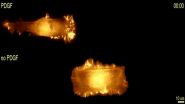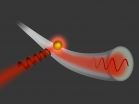(Press-News.org) Worldwide there have been 71 documented cases of patients with anaplastic large cell lymphoma (ALCL) in which researchers suspected breast implants to be the cause. ALCL is normally found in the lymph nodes, as well as in skin, lung, liver and soft tissue, but not usually in the breast. Cases in which ALCL developed in the breast region almost exclusively involved patients who have had breast surgery. In these cases, ALCL developed around ten years after the operation. The tumours grew in the scar tissue around the implant.
Breast implants are generally safe and studies have found no association between breast surgery and other forms of cancer. ALCL itself is also an extremely rare occurrence. Among three million breast implants, there are between one and six reported cases of ALCL.
ALCL is divided into two subtypes. In one subtype, the cancerous cells produce an abnormal form of the protein ALK (anaplastic lymphoma kinase). The other type does not express ALK in tumour cells at all. While patients with ALK-positive lymphoma have a better chance of survival, the cancer is considerably more aggressive in ALK-negative cases.
Implant-related ALCL appears to form a third group. The cells do not express ALK, but patients have good survival rates. "This is a previously unrecognized, new subtype of ALCL," Lukas Kenner explains. "We must now determine the exact causes behind its occurrence."
The search for causes
The actual reasons why implants can cause lymphoma remain unclear. While some patients were successfully treated with chemotherapy and radiation therapy, the lymphoma in many cases subsided on its own following removal of the implant and the surrounding tissue. An abnormal immune response from the body could therefore be a cause of the cancer. Kenner and his team are now preparing for further studies in which implants and dentures will be examined in other parts of the body.
INFORMATION:
Lukas Kenner from the Medical University Vienna, the University of Veterinary Medicine, Vienna and the Ludwig Boltzmann Institute for Cancer Research cooperated for this study with scientists from Cambridge, Liverpool, Swansea and Australia. The project was funded by the British organisation Leukaemia & Lymphoma Research.
Link between breast implants and cancer under investigation
2014-10-06
ELSE PRESS RELEASES FROM THIS DATE:
Atmospheric chemistry hinges on better physics model
2014-10-06
New theoretical physics models could help us better grasp the atmospheric chemistry of ozone depletion. Indeed, understanding photoabsorption of nitrous oxide (N2O) — a process which involves the transfer of the energy of a photon to the molecule — matters because a small fraction of N2O reacts with oxygen atoms in the stratosphere to produce among others nitric oxide (NO). The latter participates in the catalytic destruction of ozone (O3). Now, new theoretical work unveils the actual dynamic of the photoabsorption of nitrous oxide molecules. These findings by Mohammad ...
Basel scientists are bringing cells on the fast track
2014-10-06
VIDEO:
The cell stimulated with the growth factor PDGF (upper cell) migrates targeted in only one direction on its track, while the not stimulated cell (lower cell) changes its direction of...
Click here for more information.
During cancer metastasis, immune response or the development of organisms, cells are moving in a controlled manner through the body. Researchers from the Department of Biomedicine at the University of Basel discovered novel mechanisms of cell migration by ...
Liquid DNA behind virus attacks
2014-10-06
Viruses can convert their DNA from solid to fluid form, which explains how viruses manage to eject DNA into the cells of their victims. This has been shown in two new studies carried out by Lund University in Sweden.
Both research studies are about the same discovery made for two different viruses, namely that viruses can convert their DNA to liquid form at the moment of infection. Thanks to this conversion, the virus can more easily transfer its DNA into the cells of its victim, which thus become infected. One of the studies investigated the herpes virus, which infects ...
Nanoparticles break the symmetry of light
2014-10-06
This news release is available in German.
How can a beam of light tell the difference between left and right? At the Vienna University of Technology (TU Wien) tiny particles have been coupled to a glass fibre. The particles emit light into the fibre in such a way that it does not travel in both directions, as one would expect. Instead, the light can be directed either to the left or to the right. This has become possible by employing a remarkable physical effect – the spin-orbit coupling of light. This new kind of optical switch has the potential to revolutionize ...
Tumors might grow faster at night
2014-10-06
They emerge at night, while we sleep unaware, growing and spreading out as quickly as they can. And they are deadly. In a surprise finding that was recently published in Nature Communications, Weizmann Institute of Science researchers showed that nighttime is the right time for cancer to grow and spread in the body. Their findings suggest that administering certain treatments in time with the body's day-night cycle could boost their efficiency.
This finding arose out of an investigation into the relationships between different receptors in the cell – a complex network ...
Researchers redefine hypothesis on holes in the brain
2014-10-06
Over the years, researchers have described how some of the body's cells have giant channels – a kind of holes that completely uncritically allow both small and large molecules to penetrate into and out of the cell. The hypothesis is that these normally closed gatekeeper proteins in the cell membrane allow unrestricted access in the event of diseases such as myocardial infarction, stroke or Alzheimer's. If the hypothesis was correct, the obvious choice would be to look for novel drugs to block the relevant membrane proteins and in this way cure or prevent disease.
New ...
Tracing our ancestors at the bottom of the sea
2014-10-06
A specialist group of European researchers are studying the remains of prehistoric human settlements which are now submerged beneath our coastal seas. Some of these drowned sites are tens of thousands of years old. From the progressive discovery and analysis of these prehistoric remains, a new scientific field has emerged, combining the expertise from many disciplines including archaeology, oceanography and the geosciences. The new field is called Continental Shelf Prehistoric Research.
This rapidly evolving research field is the focus of a new European Marine Board ...
MFM specialists contribute to Clinical Expert Series in Obstetrics & Gynecology
2014-10-06
Since the first human fetal surgery was reported in 1965, several different fetal surgical procedures have been developed and perfected, resulting in significantly improved outcomes for many fetuses. However, the significant investments associated with this highly specialized service and quality metrics must be considered as more fetal treatment programs are developed.
Katharine D. Wenstrom, MD, director of the Division of Maternal-Fetal Medicine at Women & Infants Hospital of Rhode Island, co-director of the hospital's Integrated Program for High-Risk Pregnancy, and ...
Why does toothpaste make orange juice taste awful? (video)
2014-10-06
WASHINGTON, Oct. 6, 2014 — It's happened to many of us: Half asleep in the morning, you finish brushing your teeth and reach for your daily glass of orange juice. After taking a big swig, you spit it back out, making a face like you've just chewed on a lemon. Turns out, a specific chemical in your toothpaste is responsible for that nasty taste. This week, Reactions explains why toothpaste and orange juice don't mix. Learn all about it at https://www.youtube.com/watch?v=9X5_gtel-c0.
Subscribe to the series at Reactions YouTube, and follow us on Twitter @ACSreactions to ...
Pressing the accelerator on quantum robotics
2014-10-06
Quantum computing will allow for the creation of powerful computers, but also much smarter and more creative robots than conventional ones. This was the conclusion arrived at by researchers from Spain and Austria, who have confirmed that quantum tools help robots learn and respond much faster to the stimuli around them.
Quantum mechanics has revolutionised the world of communications and computers by introducing algorithms which are much quicker and more secure in transferring information. Now researchers from the Complutense University of Madrid (UCM) and the University ...




